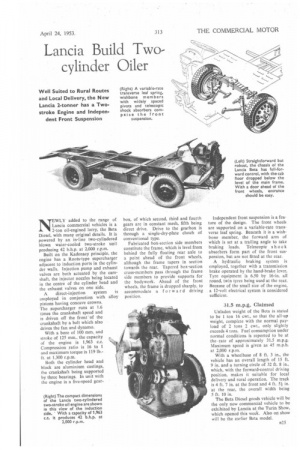Lancia Build Two cylinder Oiler
Page 59

If you've noticed an error in this article please click here to report it so we can fix it.
Well Suited to Rural Routes and Local Delivery, the New Lancia 2-tonner has a Twostroke Engine and Indepen dent Front Suspension
NEWLY added to the range of Lancia commercial vehicles is a 2-ton oil-engined lorry, the Beta Diesel, with many original details. It is powered by an in-line two-cylindered blown water-cooled two-stroke unit producing 42 b.h.p. at 2,000 r.p.m.
Built on the Kadenacy principle, the engine has a Roots-type supercharger adjacent to induction ports in the cylinder walls. Injection pump and exhaust valves are both actuated by the camshaft, the injector nozzles being located in the centre of the cylinder head and the exhaust valves on one side.
A direct-injection system is employed in conjunction with alloy pistons having concave crowns. The supercharger runs at 1.6 times the crankshaft speed and is driven off the front "of the crankshaft by a belt which also drives the fan and dynamo.
With a bore of 100 mm. and stroke of 125 mm,, the capacity of the engine is 1,963 c.c. Compression ratio is 16 to 1 and maximum torque is 119 lb.ft. at 1.300 r.p.m.
Both the cylinder head and block are aluminium castings, the crankshaft being supported by three bearings. In unit with the engine is a five-speed gear box, of which second, third and fourth gears are in constant mesh, fifth being direct drive. Drive to the gearbox is through a single-dry-plate clutch of conventional type.
Fabricated box-section side members constitute the frame, which is level from behind the fully floating rear axle to a point ahead of the front wheels, although the frame tapers in section towards the rear. Tapered box-section cross-members pass through the frame side members to provide supports for the bodywork. Ahead of the front wheels, the frame is dropped sharply, to accommodate a f orward driving position. Independent front suspension is a feature of the design. The front wheels are supported on a variable-rate transverse leaf spring. Beneath it is a wishbone member, the forward arm of which is set at a trailing angle to take braking loads. Telescopic shock absorbers form part of the front suspension, hut are not fitted at the rear.
A hydraulic braking system is employed, together with a transmission brake operated by the hand-brake lever. Tyre equipment is 6.50 by 16-in. all round, twin tyres being used at the rear. Because of the small size of the engine, a 12-volt electrical system is considered sufficient.
31.5 m.p.g. Claimed
Unladen weight of the Beta is staled to be I ton 16 cwt., so that the all-up weight, complete with the normal payload of 2 tons 2 cwt., only slight:y exceeds 4 tons. Fuel consumption under normal conditions is reported to be at therate of approximately 31.5 m.p.g. Maximum speed is given as 45 m.p.h. at 2,000 r.p.m.
With a wheelbase of 8 ft. 310., the vehicle has an overall length of 15 ft. 9 in. and a turning circle of 32 ft. 8 in., which, with the forward-control driving position, makes it suitable for local delivery and rural operation. The track is 4 ft. 7 in. at the front and 4 ft. 5i in. at the rear, the overall width being 5 ft. 10 in.
The Beta Diesel goods vehicle will be the only new commercial vehicle to be exhibited by Lancia at the Turin Show, which opened this week. Also on show will he the earlier Beta model.




































































































